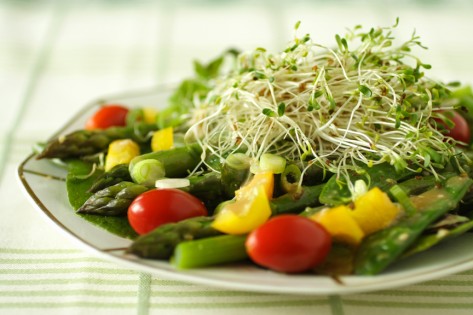Springtime Asparagus and a Newfound Favorite Vinaigrette
This spring was my first real asparagus harvest. Last season, the bed, then just one year old, was an exercise in restraint; there was just a handful of asparagus large enough to be picked. With asparagus, immediate gratification is a bad thing: If you over indulge when the asparagus bed is too young, and the asparagus are too thin, the roots will not have an opportunity to establish themselves, which is necessary for a good strong bed with years of productivity ahead.* Even this year, there were many asparagus that I deemed too thin to pick. Even so, I had enough to grill, blanch and sauté, and try two asparagus recipes from Crescent Dragonwagon’s cookbook, Dairy Hollow House Soup & Bread: Asparagus and White Wine Soup and Composed Salad of Asparagus and Snow Peas, shown below.

The soup, made with few ingredients—basically cream, milk, white wine, and cheddar cheese—and thickened with a roux, is nicely suited to this spring vegetable. It was creamy and rich, but not heavy, and being fairly simple, did not camouflage the delicate flavor of the main ingredient. I made one small change to the recipe: I set aside a portion of the asparagus tips, blanched and refreshed them in ice water, and then added them to the soup to warm through just before serving.
The salad is a beautiful combination of shapes and colors: asparagus spears, dark green snow peas, round cherry tomatoes, diced yellow bell peppers, sliced scallions, and wispy alfalfa sprouts. The Sherried Sesame Vinaigrette that binds all of these bright flavors together is impressive. I love a good vinaigrette—something that keeps well for a few days or more in the refrigerator and is flexible enough to dress most any combination of greens and fixings.
This Japanese-inspired vinaigrette does all of this, and even remains emulsified after sitting for days in the refrigerator. It has an appealing balance of sweet, salty, and nutty, and, being thickened by the miso paste and tahini, would also serve nicely as a crudité dip. Crescent Dragonwagon offers a couple of substitution options in her recipe: mirin can be substituted for sherry, peanut butter for tahini. I used mirin and tahini. (Dairy Hollow House Soup & Bread was published nearly twenty years ago; back then, suggesting substitutions for Asian or Middle Eastern ingredients, when possible, would have been necessary and very helpful.)
*Barbara Kingsolver, in Animal, Vegetable, Miracle: A Year of Food Life, urges asparagus harvesters to wait until the plant has had not one but two full summers to bulk up before picking. The chapter “Waiting for Asparagus” is the jewel of Animal, Vegetable, Miracle, and a worthwhile read for anyone with plans for an asparagus bed.)
Sherried Sesame Vinaigrette
(From Dairy Hollow House Soup & Bread: A Country Inn Cookbook by Crescent Dragonwagon, with minute changes.)
Makes 1¾ cups
1 (2-inch) piece fresh ginger, peeled and finely chopped or grated on a microplane
2 cloves garlic, roughly chopped
¼ cup light miso paste
⅓ cup rice vinegar (also called rice wine vinegar; see Notes)
¼ cup sweet sherry or mirin
2 tablespoons tamari or shoyu soy sauce
2 tablespoons honey
2 tablespoons tahini or creamy, unsweetened and unsalted peanut butter
Tiny pinch of cayenne pepper
⅔ cup peanut oil
2 tablespoons toasted sesame oil
¼ cup sesame seeds, toasted (see Notes)
Place all ingredients except the oils and sesame seeds in a food processor and process until smooth. With the machine running, slowly pour the oils through the feed tube, and process until emulsified. Add the sesame seeds and process with a few on/off pulses, just to combine.
Notes
Rice vinegar comes in two versions: seasoned (“Seasoned Gourmet”) and unseasoned (“Genuine Brewed”). The seasoned version is sweetened slightly with sugar. The exact type isn’t specified in Crescent Dragonwagon’s recipe, but the seasoned version is recommended for sauces and dressings and is the most common to find in stores, so I’ve assumed that probably this is the one the author intends for her vinaigrette.
To toast sesame seeds, place the sesame seeds in a skillet and set over medium heat. Toast, stirring the seeds or shaking the pan frequently, until the seeds are golden brown and aromatic, about 2 to 3 minutes.
